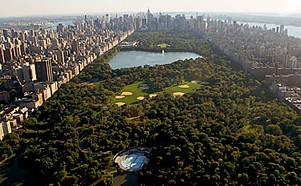考研阅读精选:曼哈顿—美国花园城市的典范
来源:新东方在线
发布时间:2017-01-05
『正是由于人口密集,曼哈顿城市采取了高效利用各种资源的措施如普及公共交通,更新公共取暖设施等,所以相对其他城市而言,曼哈顿足以称得上是环保城市的典范。』
America’s Environmental Garden Spot: Would You Believe Manhattan?
曼哈顿—美国花园城市的典范,你相信吗?
May 6, 2011 | from Time

What’s the greenest place in America? If you answered something like the granola-crunchy, Rocky Mountain-high town of Boulder, or the warm sunlight of Santa Barbara, you’d be wrong. The greenest place in America is almost devoid of nature — the buildings outnumber the trees — and the air isn’t all that great. But what it has is density and efficiency — the twin qualities that ultimately define green in the global warming era. Applying those standards, the greenest place in America is New York City — specifically, the overcrowded, overpriced and sometimes overwrought island of Manhattan, which has a per-capita greenhouse gas footprint less than 30% that of the national average.
It’s that density that makes Manhattan, and New York City as a whole, so green. Manhattan’s population density is 800 times the national average. Density comes with negatives, certainly — small living spaces, air pollution, lots and lots of concrete — but it also enables amazing efficiencies. More than 80% of Manhattanites travel to work by public transit, by bike or on foot — compared to an average of about 8% everywhere else in the country. The vertical apartment buildings that Manhattanites live in are far more energy-efficient than single-dwelling housing in the suburbs. “Most Americans think of New York City as an ecological nightmare, a wasteland of concrete and diesel fumes and traffic jams,” wrote David in his 2009 book Green Metropolis. “But in comparison with the rest of America it’s a model of environmental responsibility.”
What’s true of New York City is true of other American urban areas, albeit to a lesser degree, which is why a growing part of the environmental movement now focuses on greening cities, with the hope of attracting more Americans back downtown and reversing suburban flight. From deep-green capitals like Portland to unexpected success stories like Minneapolis, there’s an effort to make cities more sustainable, by improving public transit, reducing air pollution and upgrading energy efficiency. But even more important, there’s a much-needed push underway to reverse decades of government policies that have been weighted against cities in favor of the suburbs, with disastrous consequences for energy, the environment and the climate.
That"s exactly the challenge. For all the emphasis on improving lighting efficiency in city buildings, or pushing for less wasteful boilers in apartment buildings, for all the convenience and richness of living in a city, there are downsides too — and they can be big ones. New York, for instance, has some of the highest childhood asthma rates in the U.S. As Owen points out in a book, on a per-capita basis Manhattan is an environmental utopia, but on a per sq. ft basis it can still be an environmental catastrophe.
So it’s welcome news that New York under Mayor Michael Bloomberg has continued to push its PlaNYC scheme, an innovative long-term program to make the city greener and more sustainable over the next couple of decades. Last month Bloomberg announced an update to the plan that includes the phasing out of heavy heating oils in New York City apartment buildings. The rules will phase out the worst heating oils by 2030, to be replaced chiefly with cleaner natural gas.
Those rules — along with the parks and other environmental amenities put into place under PlaNYC — should make the city more attractive to both residents and potential residents, with net positive results for the environment. Of course, urban life isn’t for everyone. These cities can be expensive and cramped, and there are days when I just can’t face the A train. But don’t doubt it: if you really care about your carbon footprint, you’ll live in a city.
课程 文章 问答 资讯 评论 百科
- 比较正规的考研培训机构12-04
- 研究生考试辅导培训课程哪家好12-04
- 考研网络课程哪个比较好12-04
- 考研专业课培训哪个机构好12-02
- 哪个培训班的考研比较好11-29
- 比较靠谱的考研辅导班11-29
- 考研英语一阅读教学视频06-14
- 烟台考研英语辅导06-14
- 考研网课补习班哪个好03-04
- 考研培训班哪家网校好03-04
- 考研辅导视频教程哪个好03-04
- 考研培训机构哪一家好03-04
- 考研培训班哪个机构的好12-04
- 考研网课机构哪个比较好12-04
- 考研专业课辅导班班哪个好12-04
- 网上哪个考研培训班靠谱12-04
- 哪个考研培训机构比较靠谱12-02
- 考研政治课程哪个网课比较好12-02
- 西综考研哪个老师讲得好03-31
- 管综考研哪个老师好03-17
- 护理考研哪个老师讲得好03-16
- 考研政治网课哪个老师好03-16
- 考研数学网课哪个老师讲得好03-15
- 考研英语网课哪个老师好03-14

